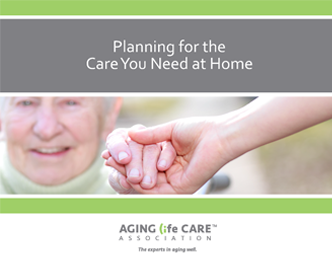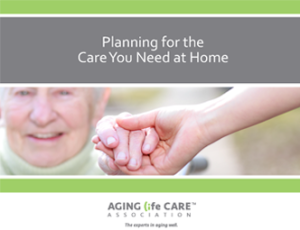
In this free eBook from the Aging Life Care Association™, you will learn how you can plan for and get the care you need at home. Planning for the Care You Need at Home also shows you how to work with your family to ensure your choices and wishes are supported.
Planning for the Care You Need at Home – a free eBook from the Aging Life Care Association™
by Phyllis Mensh Brostoff, CISW, CMC – Aging Life Care Association Member and Fellow of the Leadership Academy
Making Decisions Can Be Challenging
Most of us want to maintain the freedom to make decisions for ourselves. So when circumstances require new and possibly unwanted changes in our lives, we can feel unsure or unprepared on how to respond. You might resist suggestions on how to handle these hanges, which might include health challenges, your daily routine, or activities that you consider part of your normal day, such as driving your car.
You may find it helpful when family members help you research issues, find resources, and support your decision-making. However, as issues become more and more complex, they can be overwhelming or beyond the expertise of friends and family.
When you are facing complex problems related to aging and health issues and need multiple services at home or referrals, professional assistance can be a lifesaver.
Using real-life stories, this eBook is designed to help support you in making the decisions that are right for you.
Aging in Place
Contrary to what many believe, most people live and die in their own home. Here are some interesting statistics:
- The percent of older people 85+ years living in nursing homes has actually decreased

Download your copy today. by half from 1998 (19.8%) to 2013 (10%).Overall, the percent of all individuals 65+ living in nursing homes has
- Overall, the percent of all individuals 65+ living in nursing homes has
decreased from 4.2% in 1998 to 3.5% in 2013. This is due to the increase in alternative forms of housing that provide some supportive services, but not the entire range of services provided in nursing homes. - The majority of men (71%) over 65 live with a spouse while only 45% of women over 65 live with a spouse. These figures have not changed dramatically since 1998 when 73% of men lived with a spouse and only 41% of women did.
Download your free copy of Planning for the Care You Need at Home and learn more about:
- How to Access Services
- Non-Medical and Medical Home Care
- Home Delivered Meals
- Technology to Help You at Home
- End of Life Care
- Decision Making
- Working with an Aging Life Care Professional™
About the author: Phyllis Mensh Brostoff, CISW, CMC, is a social worker and co-founder of Stowell Associates – a care management and home care company in Milwaukee, Wisconsin. She has written numerous articles and presented seminars across the country. More information is available at www.caremanagedhomecare.com. Follow Phyllis on Twitter, Facebook, or email her at phyllisb@caremanagedhomecare.com.
This blog is for informational purposes only and does not constitute, nor is it intended to be a substitute for, professional advice, diagnosis, or treatment. Information on this blog does not necessarily reflect official positions of the Aging Life Care Association™ and is provided “as is” without warranty. Always consult with a qualified professional with any particular questions you may have regarding your or a family member’s needs.
Source: ALCA Blog